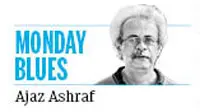The number of citizens indicating they have transcended community identities, such as those committed to egalitarian ideals or Hindutva, will likely not be insubstantial, but what will be the fallout of this?

A substantial number of poor individuals from lower castes reporting ‘no caste’ will blur the picture of the link between caste and life chances. Representation pic/istock
 Late journalist Ved Pratap Vaidik and a clutch of eminent personalities formed Sabal Bharat (Strong India), a group under whose aegis they launched a movement, Meri Jati Hindustani (My Caste is Indian), in 2010. This was a response to the rising demand for counting caste in the 2011 Census, which, they believed, would violate the constitutional ideal of citizens transcending their community identities. Vaidik simplistically said that people needed a “new caste – Indian. It’s a caste not by birth but by choice.”
Late journalist Ved Pratap Vaidik and a clutch of eminent personalities formed Sabal Bharat (Strong India), a group under whose aegis they launched a movement, Meri Jati Hindustani (My Caste is Indian), in 2010. This was a response to the rising demand for counting caste in the 2011 Census, which, they believed, would violate the constitutional ideal of citizens transcending their community identities. Vaidik simplistically said that people needed a “new caste – Indian. It’s a caste not by birth but by choice.”
History shows the decision to count caste in the 2027 Census will, as in 2010, trigger mobilisations over whether individuals should identify their castes, or merely mark themselves “Indian.” Vaidik’s favoured nomenclature of “Indian” was essentially a flashy, nationalistic substitute for “caste nil,” a return or answer the 1931 Census first allowed people to provide. Then too, as in 2010, those who opted for “caste nil” claimed to neither believe in it nor observe its rules regulating daily life.
Will the number of Indians who reported “caste nil” in 1931 have grown over nearly a century? Will a high percentage of “caste nil” herald the withering of the caste system?
Indeed, persistent mobilisation to allow people to declare ‘no caste’ was the reason for accepting “caste nil” as an answer from respondents, then Commissioner of Census JH Hutton said in his report on the 1931 Census. Census enumerators, he explained, didn’t “insist” upon asking for the caste of those belonging to caste abolitionist sects like the Arya Samaj and Brahmo Samaj, nor from Muslims, Sikhs, Christians, Buddhists and Jains, whose religions don’t recognise caste. Yet, whoever from these communities volunteered to identify their caste, their disclosure was recorded.
The mobilisation in favour of ‘no caste’ failed. Of the population of 35.28 crore in undivided India, only 18.83 lakh — roughly 0.53 per cent — reported “caste nil.” Astonishingly, 98 per cent (18.45 lakh) of them were from Bengal. Who were these people? AE Porter, in his report on the 1931 Census in Bengal, said the return of ‘no caste’ was accepted from those who “have actively ceased to conform to the caste system,” broken rules in their “marital and commensal relations” and who didn’t belong to “reforming and schismatic communities such as the Arya Samaj, Sikhs, Jains, etc.”
Of Bengal’s 2.2 crore Hindus, only 29,000 didn’t record their caste, much to Porter’s surprise. It’d seem the bulk of Indians who reported ‘no caste’ either belonged to Hindu reformist sects or were non-Hindu. Porter particularly referred to segments of Muslims stoutly opposing the recording of caste, despite its presence among them, on the ground that Islam is a “universal and democratic” faith.
On the face of it, the percentage of Indians reporting ‘no caste’ in 2027 will likely be higher than those who did so in 1931, for modernisation has had many transcend caste, even if unconsciously. They do not observe caste rules simply because they can’t. Caste segregation, for instance, isn’t possible in public transport; migration has largely severed the traditional link between caste and occupation. Far more Indians than in 1931 will justifiably think they have risen above caste.
There are also those who subscribe to the constitutional principle of egalitarianism or ideologies that have them define their identity beyond caste and religion, an example of which are the Communists. In contrast to them, Hindutvawadis strive for dissolving caste identities in the larger Hindu identity. Although caste and religion are inextricably woven in Hinduism, Hindutvawadis, too, could sincerely report ‘no caste.’
Ultimately, though, who will report ‘no caste’ will depend on whether s/he experienced stigmatisation, discrimination and exclusion on account of caste. There’s also the undeniable link between caste and life chances. The higher a person is in the caste hierarchy, the greater his/her chances of succeeding in life. For instance, in 1931 in the Bombay Presidency, 788 of every 1000 Brahmins were literate, as against 63 of every 1000 Mahars.
Such historical advantages and disadvantages have been largely reproduced today. This social reality could encourage those invested in maintaining the status quo to launch a Vaidik-like campaign in favour of reporting ‘no caste.’ A substantial number of poor individuals from lower castes reporting ‘no caste’ will blur the picture of the link between caste and life chances, making it difficult to frame policies for breaking that linkage.
Quite the opposite might be the consequence in case a large number of respondents from high castes who are also middle class mark themselves ‘no caste.’ They wouldn’t be counted as members of the castes into which they were born.
This would undoubtedly reduce the population count of their communities but also depict their socio-economic profile as relatively less privileged than they are in reality, thus undermining the claim of there being a link between caste and life chances.
Such a possibility will threaten lower caste interests and, therefore, spark a counter-mobilisation against answering ‘no caste’ in the Census. The ensuing caste competition will politically vitiate the responses in the Census. Indeed, only in the absence of a movement for marking ‘no caste’ that such a return provide a credible estimate of Indians for whom caste doesn’t matter and for gauging the degree to which the caste system has withered away.
The writer is a senior journalist and author of Bhima Koregaon: Challenging Caste.
Send your feedback to mailbag@mid-day.com
The views expressed in this column are the individual’s and don’t represent those of the paper.
 Subscribe today by clicking the link and stay updated with the latest news!" Click here!
Subscribe today by clicking the link and stay updated with the latest news!" Click here!










